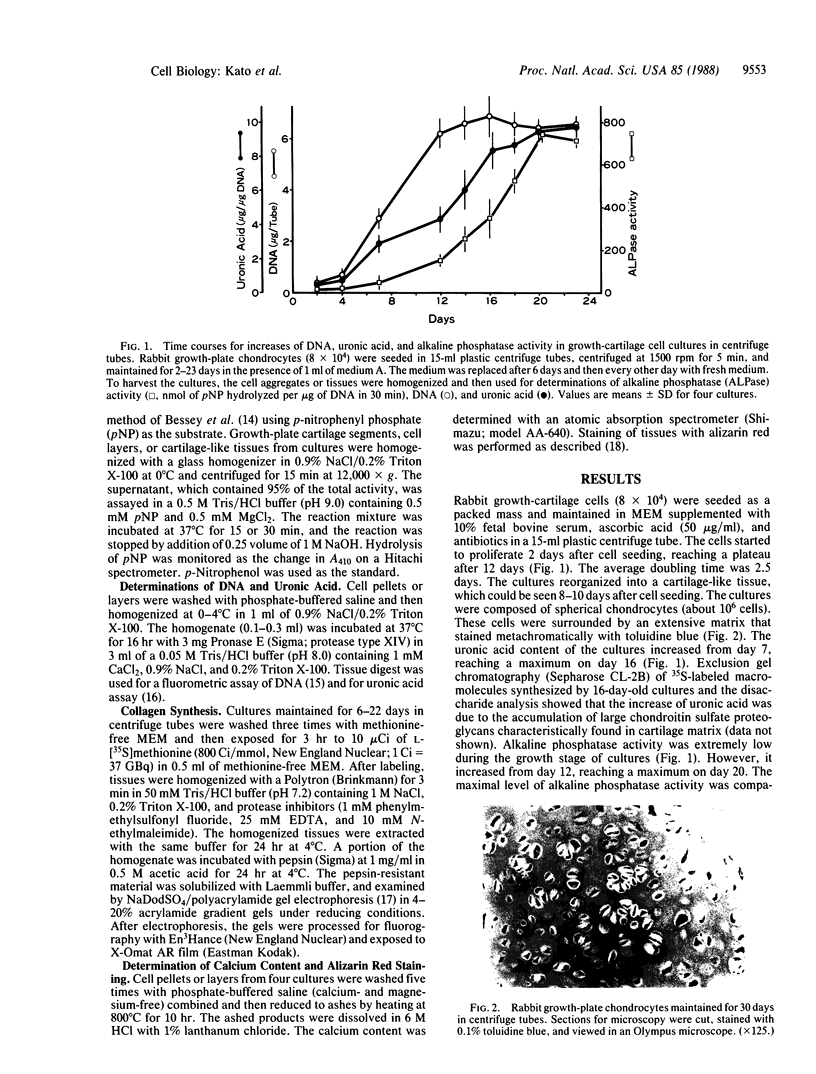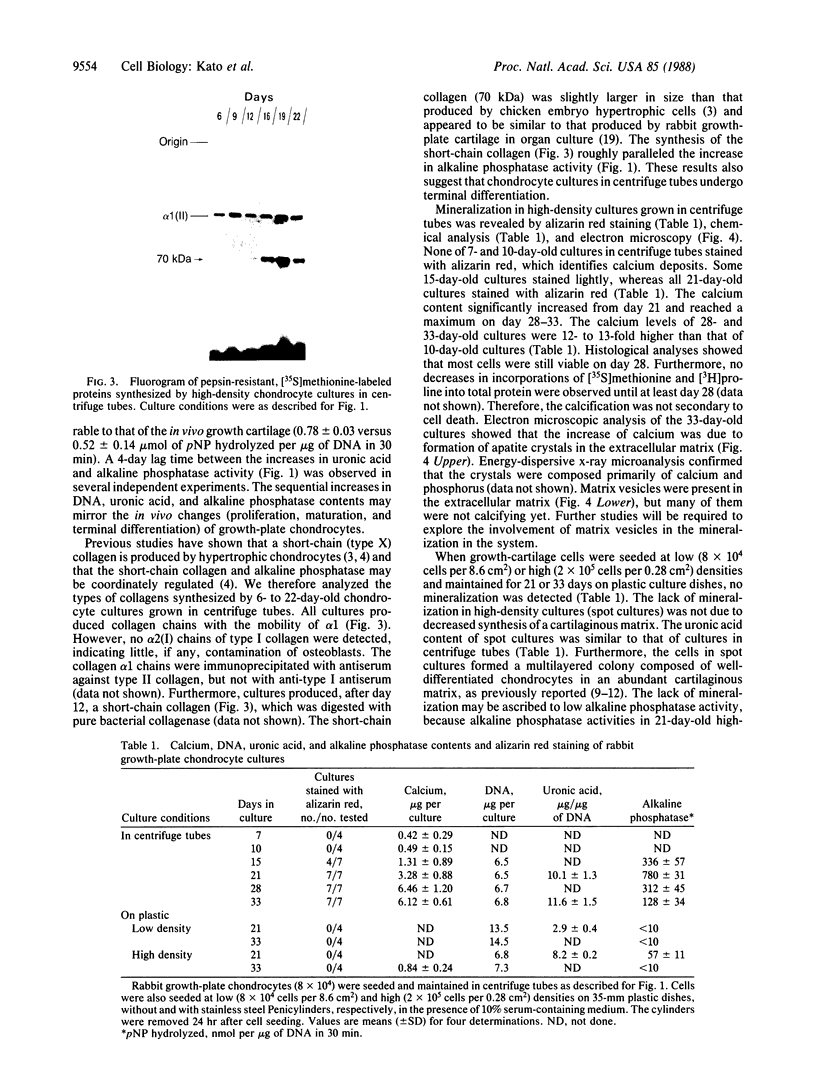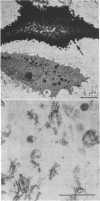Abstract
Rabbit chondrocyte cultures on plastic dishes are capable of depositing a cartilaginous matrix, although the matrix does not calcify unless high levels of phosphate are added to the medium. In the present study, we cultivated a pelleted mass of rabbit growth-plate chondrocytes in the presence of Eagle's minimum essential medium supplemented with 10% fetal bovine serum and 50 micrograms of ascorbic acid per ml in a plastic centrifuge tube. These cells proliferated for several generations and then reorganized into a cartilage-like tissue that calcified without additional phosphate. The deposition of minerals was observed only after synthesis of a short-chain collagen and alkaline phosphatase. Serum factors were required for the increases in alkaline phosphatase and calcium contents. 5-Bromo-2'-deoxyuridine abolished the increases in uronic acid, alkaline phosphatase, and calcium contents. Transforming growth factor beta, at very low concentrations, suppressed the expression of the mineralization-related phenotype by chondrocytes. These results suggest that cartilage-matrix calcification can be controlled by growth factor(s) and that chondrocytes induce the mineralization of extracellular matrix when terminal differentiation is permitted in the absence of an artificial substrate.
Full text
PDF




Images in this article
Selected References
These references are in PubMed. This may not be the complete list of references from this article.
- Abbott J., Holtzer H. The loss of phenotypic traits by differentiated cells, V. The effect of 5-bromodeoxyuridine on cloned chondrocytes. Proc Natl Acad Sci U S A. 1968 Apr;59(4):1144–1151. doi: 10.1073/pnas.59.4.1144. [DOI] [PMC free article] [PubMed] [Google Scholar]
- Alcock N. W. Calcification of cartilage. Clin Orthop Relat Res. 1972 Jul-Aug;86:287–311. doi: 10.1097/00003086-197207000-00040. [DOI] [PubMed] [Google Scholar]
- Ali S. Y., Sajdera S. W., Anderson H. C. Isolation and characterization of calcifying matrix vesicles from epiphyseal cartilage. Proc Natl Acad Sci U S A. 1970 Nov;67(3):1513–1520. doi: 10.1073/pnas.67.3.1513. [DOI] [PMC free article] [PubMed] [Google Scholar]
- Anderson H. C. Electron microscopic studies of induced cartilage development and calcification. J Cell Biol. 1967 Oct;35(1):81–101. doi: 10.1083/jcb.35.1.81. [DOI] [PMC free article] [PubMed] [Google Scholar]
- BITTER T., MUIR H. M. A modified uronic acid carbazole reaction. Anal Biochem. 1962 Oct;4:330–334. doi: 10.1016/0003-2697(62)90095-7. [DOI] [PubMed] [Google Scholar]
- Binderman I., Greene R. M., Pennypacker J. P. Calcification of differentiating skeletal mesenchyme in vitro. Science. 1979 Oct 12;206(4415):222–225. doi: 10.1126/science.482937. [DOI] [PubMed] [Google Scholar]
- Bonucci E. Fine structure of early cartilage calcification. J Ultrastruct Res. 1967 Sep;20(1):33–50. doi: 10.1016/s0022-5320(67)80034-0. [DOI] [PubMed] [Google Scholar]
- Boskey A. L. Current concepts of the physiology and biochemistry of calcification. Clin Orthop Relat Res. 1981 Jun;(157):225–257. [PubMed] [Google Scholar]
- DAHL L. K. A simple and sensitive histochemical method for calcium. Proc Soc Exp Biol Med. 1952 Jul;80(3):474–479. doi: 10.3181/00379727-80-19661. [DOI] [PubMed] [Google Scholar]
- Ellingsworth L. R., Brennan J. E., Fok K., Rosen D. M., Bentz H., Piez K. A., Seyedin S. M. Antibodies to the N-terminal portion of cartilage-inducing factor A and transforming growth factor beta. Immunohistochemical localization and association with differentiating cells. J Biol Chem. 1986 Sep 15;261(26):12362–12367. [PubMed] [Google Scholar]
- Habuchi H., Conrad H. E., Glaser J. H. Coordinate regulation of collagen and alkaline phosphatase levels in chick embryo chondrocytes. J Biol Chem. 1985 Oct 25;260(24):13029–13034. [PubMed] [Google Scholar]
- Hinegardner R. T. An improved fluorometric assay for DNA. Anal Biochem. 1971 Jan;39(1):197–201. doi: 10.1016/0003-2697(71)90476-3. [DOI] [PubMed] [Google Scholar]
- Hiraki Y., Inoue H., Hirai R., Kato Y., Suzuki F. Effect of transforming growth factor beta on cell proliferation and glycosaminoglycan synthesis by rabbit growth-plate chondrocytes in culture. Biochim Biophys Acta. 1988 Apr 2;969(1):91–99. doi: 10.1016/0167-4889(88)90092-4. [DOI] [PubMed] [Google Scholar]
- Holtzer H., Abbott J., Lash J., Holtzer S. THE LOSS OF PHENOTYPIC TRAITS BY DIFFERENTIATED CELLS IN VITRO, I. DEDIFFERENTIATION OF CARTILAGE CELLS. Proc Natl Acad Sci U S A. 1960 Dec;46(12):1533–1542. doi: 10.1073/pnas.46.12.1533. [DOI] [PMC free article] [PubMed] [Google Scholar]
- Laemmli U. K. Cleavage of structural proteins during the assembly of the head of bacteriophage T4. Nature. 1970 Aug 15;227(5259):680–685. doi: 10.1038/227680a0. [DOI] [PubMed] [Google Scholar]
- Oakes B. W., Handley C. J., Lisner F., Lowther D. A. An ultrastructural and biochemical study of high density primary cultures of embryonic chick chondrocytes. J Embryol Exp Morphol. 1977 Apr;38:239–263. [PubMed] [Google Scholar]
- Palmoski M. J., Goetinck P. F. Synthesis of proteochondroitin sulfate by normal, nanomelic, and 5-bromodeoxyuridine-treated chondrocytes in cell culture. Proc Natl Acad Sci U S A. 1972 Nov;69(11):3385–3388. doi: 10.1073/pnas.69.11.3385. [DOI] [PMC free article] [PubMed] [Google Scholar]
- Remington M. C., Bashey R. I., Brighton C. T., Jimenez S. A. Biosynthesis of a low molecular weight collagen by rabbit growth plate cartilage organ cultures. Coll Relat Res. 1983 May;3(3):271–277. doi: 10.1016/s0174-173x(83)80009-0. [DOI] [PubMed] [Google Scholar]
- Robison R. The Possible Significance of Hexosephosphoric Esters in Ossification. Biochem J. 1923;17(2):286–293. doi: 10.1042/bj0170286. [DOI] [PMC free article] [PubMed] [Google Scholar]
- Schmid T. M., Conrad H. E. Metabolism of low molecular weight collagen by chondrocytes obtained from histologically distinct zones of the chick embryo tibiotarsus. J Biol Chem. 1982 Oct 25;257(20):12451–12457. [PubMed] [Google Scholar]
- Seyedin S. M., Thompson A. Y., Bentz H., Rosen D. M., McPherson J. M., Conti A., Siegel N. R., Galluppi G. R., Piez K. A. Cartilage-inducing factor-A. Apparent identity to transforming growth factor-beta. J Biol Chem. 1986 May 5;261(13):5693–5695. [PubMed] [Google Scholar]
- Shimomura Y., Yoneda T., Suzuki F. Osteogenesis by chondrocytes from growth cartilage of rat rib. Calcif Tissue Res. 1975 Dec 22;19(3):179–187. doi: 10.1007/BF02564002. [DOI] [PubMed] [Google Scholar]
- Suzuki F., Takase T., Takigawa M., Uchida A., Shimomura Y. Simulation of the initial stage of endochondral ossification: in vitro sequential culture of growth cartilage cells and bone marrow cells. Proc Natl Acad Sci U S A. 1981 Apr;78(4):2368–2372. doi: 10.1073/pnas.78.4.2368. [DOI] [PMC free article] [PubMed] [Google Scholar]





